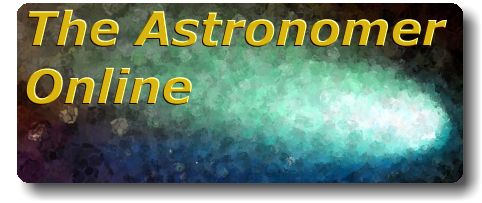Contents
- TA details
- Homepage
- Magazine index
- Our history
- Contact details
- Subscription
- Discovery procedure
- Meeting reports
- Youtube channel
- Members' services
- E-circular archive
- On-line charts
- Sales
- Chart catalogue
- Special publications
- Back issues
- Videos
- Advertising rates
- Observations
- Aurora/NLC
- Comets
- Deep sky
- Eclipses/Transits
- Gamma Ray Bursts
- Meteors
- Minor planets
- Planets
- Sun
- Supernovae
- TNOs
- Novae/Variables
- Links
- Vizie-R
- JPL Horizons
- IAU Central Bureau
- Minor Planet Center
- Heavens Above
- BAA
- Further links
|
|
V1548 Aql = Nova Aquilae 2001 = TAV J1907+117
Position: 19 07 28.41 +11 44 45.8 [2000] (NDJ, 15 GSC stars)
Mike Collins noted that the object appeared bright on 11 May 2001, visible on an
exposure pair taken on 25 April 2001 and possibly at the
film limit on 1 April. No identifications found in the
GSC, USNO, IRAS catalogues. 2MASS does not cover area.
Nick James confirmed the suspect measuring a position:
19h 07m 28.41s +11d 44' 45.8 (2000) using 15 GSC stars.
I.A.U. Circ. 7627 reported object as "possible nova".
Spectral confirmation obtained by Chris Benn using
Isaac Newton 98-inch shows classical nova spectrum.
Uemura et al. measured position with end figures 28.425
and 45.78.
Further details can be found on the following IAU Circulars:
7627,
7628,
7639.
- Images
- 2001 May 11.99. (Discovery - Mike Collins)
- 2001 May 16.97. (Confirmation - Nick James. V-Band CCD)
- NDJ image and DSS overlay. This
image shows Nick James' confirmation image of May 16 overlayed on the sky
survey red plate. Yellow blobs are stars on the confirmation image and black
blobs are stars on the DSS. It can be seen that there is no obvious DSS
candidate at the location of the nova.
- 2001 May 18.98. (Nick James. V-Band CCD)
- 2001 May 18.98. (Jean-Gabriel Bosch. Unfiltered CCD)
- 2001 May 19.02. (Mark Armstrong. Unfiltered CCD)
- 2001 May 20.95. (Nick James. V-Band CCD)
- 2001 May 22.92. (Martin Mobberley, unfiltered CCD)
- 2001 May 23.95. (Nick James. V-Band CCD)
- 2001 May 31.95. (Nick James. V-Band CCD)
- 2001 June 4.07. (Mark Armstrong. Unfiltered CCD)
- 2001 June 9.93. (Maurice Gavin. Unfiltered CCD)
- 2001 June 11.06. (Mark Armstrong. Unfiltered CCD)
- 2001 June 13.99. (Maurice Gavin. Unfiltered wide-field CCD)
- 2001 Aug 20.899. (Nick James. V-Band CCD)
- 2002 November 12. (Maurice Gavin)
- Spectra
- Confirmation spectrum.
Chris Benn (Manager, William Herschel Telescope) writes:
We observed the candidate nova in Aquila with with the IDS
spectrograph (10 A resolution) on the 2.5-m Isaac Newton Telescope,
La Palma, on 2001 May 18 at 02:50 UT. The spectrum is clearly that
of a nova, with strong Halpha, Hbeta, Hgamma and the usual He and Fe
lines. The signal-to-noise on the spectrum is ~ 100 per pixel
step in wavelength.
- 2001 May 18.
Maurice Gavin
obtained the first amateur spectral confirmation. He writes:
From a series of lo-res spectra [5nm/pixel] taken this evening all show this
object has the characteristics of a nova at outburst with Halpha very strong.
Judging from the spectra the object should be orange in colour. A shell star,
Beta Lyrae, with He and Halpha in emission, taken during the same session is
included for comparison.
- 2001 May 21.02
(raw image) Maurice Gavin and
plotted spectrum
compared with the INT spectrograph of 2001 May 18.
- Charts
- B chart.
- C chart.
- Lightcurves
- lightcurve (updated
2001 December 20). A great deal of scatter is present in the estimates, probably
due to observers using different sequences and the fact that the nova is very
red.
|



